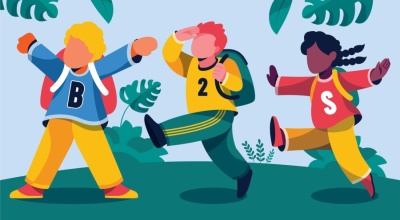Biased or Opinionated Sources - Wikipedia articles are required to present a neutral point of view. However, reliable sources are not required to be neutral, unbiased, or objective. Sometimes non-neutral sources are the best possible sources for supporting information about the different viewpoints held on a subject.
Video: Bias Police Problem, Bias Preschool Problem
Bias Isn't Just A Police Problem, It's A Preschool Problem | Let's Talk | NPR
A new study by researchers at Yale found that pre-K teachers, white and black alike, spend more time watching black boys -- expecting trouble. NPR reports
Bias Types from Wikipedia
A statistic is biased if it is calculated in such a way that it is systematically different from the population parameter being estimated. The following lists some types of biases, which can overlap.
- Selection bias involves individuals being more likely to be selected for study than others, biasing the sample. This can also be termed Berksonian bias.
--Spectrum bias arises from evaluating diagnostic tests on biased patient samples, leading to an overestimate of the sensitivity and specificity of the test.
- The bias of an estimator is the difference between an estimator's expected value and the true value of the parameter being estimated.
--Omitted-variable bias is the bias that appears in estimates of parameters in regression analysis when the assumed specification omits an independent variable that should be in the model.
- In statistical hypothesis testing, a test is said to be unbiased if, for some alpha level (between 0 and 1), the probability the null is rejected is less than or equal to the alpha level for the entire parameter space defined by the null hypothesis, while the probability the null is rejected is greater than or equal to the alpha level for the entire parameter space defined by the alternative hypothesis.
- Detection bias occurs when a phenomenon is more likely to be observed for a particular set of study subjects. For instance, the syndemic involving obesity and diabetes may mean doctors are more likely to look for diabetes in obese patients than in thinner patients, leading to an inflation in diabetes among obese patients because of skewed detection efforts.
- In educational measurement, bias is defined as "Systematic errors in test content, test administration, and/or scoring procedures that can cause some test takers to get either lower or higher scores than their true ability would merit. The source of the bias is irrelevant to the trait the test is intended to measure."
- Funding bias may lead to the selection of outcomes, test samples, or test procedures that favor a study's financial sponsor.
- Reporting bias involves a skew in the availability of data, such that observations of a certain kind are more likely to be reported.
- Analytical bias arises due to the way that the results are evaluated.
- Exclusion bias arise due to the systematic exclusion of certain individuals from the study.
- Attrition bias arises due to a loss of participants e.g. loss to follow up during a study.
- Recall bias arises due to differences in the accuracy or completeness of participant recollections of past events. e.g. a patient cannot recall how many cigarettes they smoked last week exactly, leading to over-estimation or under-estimation.
- Observer bias arises when the researcher subconsciously influences the experiment due to cognitive bias where judgment may alter how an experiment is carried out / how results are recorded.
Multicultural biases and Education
Definition of antibias: opposing or prohibiting unfair discrimination against people based on race, religion, etc. : preventing or counteracting bias (as in hiring practices) merriam-webster.com/dictionary/antibias
Anti-bias education is an approach to teaching and learning designed to increase understanding of differences and their value to a respectful and civil society and to actively challenge bias, stereotyping and all forms of discrimination in schools and communities.
Multicultural curriculum taught basic facts about different cultures, often on specially designated culture days or holidays, rather than being systematically infused into the entire curriculum. While this did increase students' superficial knowledge of other cultures, educators wanted students to know why they didn't know about other cultures and why certain people of certain ethnicities and classes are less likely to be economically successful.
The objectives of the anti-bias curriculum are to raise awareness of bias and to reduce bias. Anti-bias curriculum transgresses the boundaries by actively providing children with a solid understanding of social problems and issues while equipping them with strategies to combat bias and improve social conditions for all.
Cultural bias is the phenomenon of interpreting and judging phenomena by standards inherent to one's own culture. The phenomenon is sometimes considered a problem central to social and human sciences, such as economics, psychology, anthropology, and sociology. Some practitioners of the aforementioned fields have attempted to develop methods and theories to compensate for or eliminate cultural bias.
Video: Anti-Bias Lessons Help Preschoolers Hold Up a Mirror to Diversity
Some California preschools are getting children to participate in conversations about racial differences at an early age by introducing an anti-bias curriculum that teaches kids about diversity and inclusion. Against a backdrop of national divides over race, these educators use art projects and discussions to infuse a powerful message into the classroom. Special correspondent Cat Wise reports.
We Recommend
Partner with organizations, children’s museums, schools, and families across the country to promote access to children’s books centering underrepresented and oppressed groups.
- The Conscious Kid is an education, research and policy organization dedicated to reducing bias and promoting positive identity development in youth.
- American Indians in Children’s Literature
- ADL’s Education Department provides educational programs, training and resources for grades PreK-12 and college/university settings. Our anti-bias and bullying prevention programs assist educators and students in understanding and challenging bias and building ally behaviors. Our work in confronting anti-Semitism empowers young people with constructive responses to combat anti-Semitism. We also have programs and resources to help students explore and critically reflect on the lessons of the Holocaust.
- The National Association for the Education of Young Children (NAEYC) is a professional membership organization that works to promote high-quality early learning for all young children, birth through age 8, by connecting early childhood practice, policy, and research. We advance a diverse, dynamic early childhood profession and support all who care for, educate, and work on behalf of young children. The association comprises nearly 60,000 individual members of the early childhood community and more than 50 Affiliates, all committed to delivering on the promise of high-quality early learning. Together, we work to achieve a collective vision: that all young children thrive and learn in a society dedicated to ensuring they reach their full potential.
Public Downloads
All items are free to view, share, and download.
Public Downloads - Español (Spanish)
When available, we provide all our content with a Spanish version in our public download section. You can find additional material from sources listed in all our articles.
Download Anti-Bias Books Guides
 A Selected Listing of Titles for Cultural Diversity an Annotated Bibliography
A Selected Listing of Titles for Cultural Diversity an Annotated Bibliography
 Anti-Bias Classroom Observation Checklist Environmental Evaluation
Anti-Bias Classroom Observation Checklist Environmental Evaluation
 Anti-Bias Education for Young Children and Ourselves by National Association for the Education of Young Children
Anti-Bias Education for Young Children and Ourselves by National Association for the Education of Young Children
 Anti-bias Education Goals - Holidays
Anti-bias Education Goals - Holidays
 Anti-Bias Strategies
Anti-Bias Strategies
 Appreciate Diversity for Youth and Adults Educational Activity Book
Appreciate Diversity for Youth and Adults Educational Activity Book
 Assessing Children’s Book Collections Guide for Selecting Anti-Bias Children’s Books
Assessing Children’s Book Collections Guide for Selecting Anti-Bias Children’s Books
 Bias Isn't Just A Police Problem, It's A Preschool Problem MP3
Bias Isn't Just A Police Problem, It's A Preschool Problem MP3
 Bias Isn't Just A Police Problem, It's A Preschool Problem Video
Bias Isn't Just A Police Problem, It's A Preschool Problem Video
 Children's Research Collection of Books - The ABC of It - Further Reading
Children's Research Collection of Books - The ABC of It - Further Reading
 Children’s Book List About Friendships and Feelings
Children’s Book List About Friendships and Feelings
 Childrens Books-Infographic 2018
Childrens Books-Infographic 2018
 Collection of Black Books Matter Children's Books Celebrating Black Boys
Collection of Black Books Matter Children's Books Celebrating Black Boys
 Cultural Diversity an Annotated Bibliography
Cultural Diversity an Annotated Bibliography
 Diverse Resources of Native American Perspective
Diverse Resources of Native American Perspective
 Diversity Activities, Information, and Resources Guide
Diversity Activities, Information, and Resources Guide
 Diversity and Inclusion Adaptable Icebreakers Educational Activities
Diversity and Inclusion Adaptable Icebreakers Educational Activities
 Diversity in Childrens Books 2018
Diversity in Childrens Books 2018
 Diversity, Anti-bias Checklist Questions for Evaluation
Diversity, Anti-bias Checklist Questions for Evaluation
 Evaluating Children’s Books that Address Disability
Evaluating Children’s Books that Address Disability
 Guide to Analyze Children’s Books for Racism and Sexism
Guide to Analyze Children’s Books for Racism and Sexism
 Guide to Teaching Children to Resist Bias
Guide to Teaching Children to Resist Bias
 List of Anti-Bias Children’s Books Include African American and People of Color, Social Justice, Bullying and Culture
List of Anti-Bias Children’s Books Include African American and People of Color, Social Justice, Bullying and Culture
 Nonviolence List of Terms with the Definition
Nonviolence List of Terms with the Definition
 Nonviolence on the Move - Three Act Play
Nonviolence on the Move - Three Act Play
 People First Activity Book for Language and Other Disability Issues
People First Activity Book for Language and Other Disability Issues
 Teaching Tolerance Reading for Social Justice Guide
Teaching Tolerance Reading for Social Justice Guide
 The Cat is Out of the Bag Orientalism Anti-Blackness and White
The Cat is Out of the Bag Orientalism Anti-Blackness and White
 What Is Anti-Bias Education
What Is Anti-Bias Education
 Wikipedia - Bias Types and Statistical Bias
Wikipedia - Bias Types and Statistical Bias
 Wikipedia - Cultural Bias
Wikipedia - Cultural Bias
 Wikipedia - Neutral Point of View
Wikipedia - Neutral Point of View
Download Emotional Health Activities
 A Collection of Social Emotional Lesson-Plans
A Collection of Social Emotional Lesson-Plans
 Activities for Grieving Children
Activities for Grieving Children
 Appreciate Diversity for Youth and Adults Educational Activity Book
Appreciate Diversity for Youth and Adults Educational Activity Book
 Confidence Activities
Confidence Activities
 Explore My Emotions Coloring Book
Explore My Emotions Coloring Book
 Explore My Emotions Coloring Book 2
Explore My Emotions Coloring Book 2
 Express Your Health Activity Book for Kids
Express Your Health Activity Book for Kids
 Express Your Health Activity Book for Kids Spanish Version
Express Your Health Activity Book for Kids Spanish Version
 Healthy Relationship Activity Book
Healthy Relationship Activity Book
 Helping Families Support Their LGBT Children and Community
Helping Families Support Their LGBT Children and Community
 How Do You Feel Coloring and Activity Book
How Do You Feel Coloring and Activity Book
 Mental Health Insurance Coverage - Equal Treatment Insurance Law
Mental Health Insurance Coverage - Equal Treatment Insurance Law
 Rosenwald Teaching Guide
Rosenwald Teaching Guide
 Stress Reduction Activities for Students
Stress Reduction Activities for Students
 Support LGBT Children Families are Forever
Support LGBT Children Families are Forever
 Teaching Constitution
Teaching Constitution
 Teaching Tolerance One World Poster 2016 - 1
Teaching Tolerance One World Poster 2016 - 1
 Teaching Tolerance One World Poster 2012
Teaching Tolerance One World Poster 2012
 Teaching Tolerance One World Poster 2015
Teaching Tolerance One World Poster 2015
 Teaching Tolerance One World Poster 2016 - 2
Teaching Tolerance One World Poster 2016 - 2
 Tolerance.org is the 10 Ways To Fight Hate on Campus A Response Guide for College Activists booklet
Tolerance.org is the 10 Ways To Fight Hate on Campus A Response Guide for College Activists booklet
 United Nations Universal Declaration of Human Rights Booklet
United Nations Universal Declaration of Human Rights Booklet
 Ways to Manage Emotions
Ways to Manage Emotions
Download About Empathy Activities
 Activities to Build Empathy and Community
Activities to Build Empathy and Community
 Capacity to Recognize or Understand Emotions in Your Community Activities
Capacity to Recognize or Understand Emotions in Your Community Activities
 Emotional Intelligence Activity Book and Guide for Teens 13-18 Years Old
Emotional Intelligence Activity Book and Guide for Teens 13-18 Years Old
 Empathy Toolkit Rules of Kindness Activity Book
Empathy Toolkit Rules of Kindness Activity Book
 Explore Empathy with Kids Grades 3 to 5 Healthy Activities
Explore Empathy with Kids Grades 3 to 5 Healthy Activities
 Explore Empathy with Kids Grades 9 to 12 Healthy Activities
Explore Empathy with Kids Grades 9 to 12 Healthy Activities
 Explore Empathy with Kids PreK to Grade 2 Healthy Activities
Explore Empathy with Kids PreK to Grade 2 Healthy Activities
 Introduction Empathy, Listening Skills & Relationships
Introduction Empathy, Listening Skills & Relationships
 Introduction to Increasing Empathy and Compassion Training Manual
Introduction to Increasing Empathy and Compassion Training Manual
 Learning About What Is Empathy Worksheet
Learning About What Is Empathy Worksheet
 Life and Situations People Experience Empathy Games
Life and Situations People Experience Empathy Games
 Mindfulness and Empathy Activities for Classrooms
Mindfulness and Empathy Activities for Classrooms
 Put Yourself in Someone Else’s Shoes Activity Book
Put Yourself in Someone Else’s Shoes Activity Book
 Respond with Genuine Curiosity and Empathy Activities
Respond with Genuine Curiosity and Empathy Activities
Download Disability Awareness Activities for Friends and Siblings
 100 Apps for Kids with Special Needs and Learning Differences
100 Apps for Kids with Special Needs and Learning Differences
 Autism Awareness Month Toolkit
Autism Awareness Month Toolkit
 Autism Teaching Strategies
Autism Teaching Strategies
 Awareness and Supporting Students with Disability Training Manual
Awareness and Supporting Students with Disability Training Manual
 Brochure Words and Actions Show Respect to Your Neighbors with Disabilities
Brochure Words and Actions Show Respect to Your Neighbors with Disabilities
 Brochure Words and Actions Show Respect to Your Neighbors with Disabilities Image
Brochure Words and Actions Show Respect to Your Neighbors with Disabilities Image
 Bullying Resources and Information to Families for Children with Special Needs
Bullying Resources and Information to Families for Children with Special Needs
 Children with Disabilities in Situations of Armed Conflict
Children with Disabilities in Situations of Armed Conflict
 Developmental Monitoring CDC’s Act Early Ambassadors Champions
Developmental Monitoring CDC’s Act Early Ambassadors Champions
 Developmental Monitoring Learn the Signs Act Early One Director’s Story
Developmental Monitoring Learn the Signs Act Early One Director’s Story
 Developmental Monitoring Tools for Tracking Milestones Milestone Moments Booklet Reader
Developmental Monitoring Tools for Tracking Milestones Milestone Moments Booklet Reader
 Developmental Monitoring Tools for Tracking Milestones Milestone Moments Booklet Reader - Spanish
Developmental Monitoring Tools for Tracking Milestones Milestone Moments Booklet Reader - Spanish
 Disability & Health Resources for Facilitating Inclusion and Overcoming Barriers
Disability & Health Resources for Facilitating Inclusion and Overcoming Barriers
 Disability Awareness for Parent with Children Special Needs
Disability Awareness for Parent with Children Special Needs
 Disability Awareness Poster
Disability Awareness Poster
 Disability Etiquette
Disability Etiquette
 Friends and Siblings of Children with Special Needs Tool Kit
Friends and Siblings of Children with Special Needs Tool Kit
 Hero Tales from American History by Henry Cabot Lodge and Theodore Roosevelt with audiobook recording
Hero Tales from American History by Henry Cabot Lodge and Theodore Roosevelt with audiobook recording
 Learn How To Respect Disabled Children
Learn How To Respect Disabled Children
 Money Management for People with Disabilities
Money Management for People with Disabilities
 People First Language Poster
People First Language Poster
 Resources and Information to Families for Children with Special Needs
Resources and Information to Families for Children with Special Needs
 See What Children with Disabilities Can Do
See What Children with Disabilities Can Do
 Strategies to Address Student’s Special Needs
Strategies to Address Student’s Special Needs
 Think About How You Disable Others Disability Awareness Toolkit
Think About How You Disable Others Disability Awareness Toolkit
 What is Autism Spectrum Disorder
What is Autism Spectrum Disorder
Download Disability Awareness Activity Books and Fact Sheets
 Activities That Enhance Students’ Knowledge and Understanding of Disabilities
Activities That Enhance Students’ Knowledge and Understanding of Disabilities
 Disabilities Awareness Merit Badge Workbook
Disabilities Awareness Merit Badge Workbook
 Disability 101 Lesson Plans and Activities
Disability 101 Lesson Plans and Activities
 Disability Awareness Activities Fact Sheet
Disability Awareness Activities Fact Sheet
 Disability Awareness Activities for Students of All Ages
Disability Awareness Activities for Students of All Ages
 Disability Awareness Activity Packet
Disability Awareness Activity Packet
 Disability Awareness Crossword Puzzle
Disability Awareness Crossword Puzzle
 Disability Awareness for Children and Adults Quiz and Activities Booklet
Disability Awareness for Children and Adults Quiz and Activities Booklet
 Disability Awareness for Children Information and Resource Activity Book
Disability Awareness for Children Information and Resource Activity Book
 Disability Awareness for Parent with Children Special Needs
Disability Awareness for Parent with Children Special Needs
 Example Learning Activity Your Voice Your Vote for Voters not in Indiana
Example Learning Activity Your Voice Your Vote for Voters not in Indiana
 Friends and Siblings of Children with Special Needs Tool Kit
Friends and Siblings of Children with Special Needs Tool Kit
 Healthy Relationship Activity Book
Healthy Relationship Activity Book
 People First Activity Book for Language and Other Disability Issues
People First Activity Book for Language and Other Disability Issues
 Understanding Kids Who Are Different with Disabilities Lesson Plans
Understanding Kids Who Are Different with Disabilities Lesson Plans
Download Disability Awareness Coloring Books
 Going to the Zoo Disabilities Awareness Coloring Book
Going to the Zoo Disabilities Awareness Coloring Book
 Going to the Zoo Disabilities Awareness Coloring Book - Spanish
Going to the Zoo Disabilities Awareness Coloring Book - Spanish
 Let's Ride Disabilities Awareness Coloring Book
Let's Ride Disabilities Awareness Coloring Book
 Let's Ride Disabilities Awareness Coloring Book - Spanish
Let's Ride Disabilities Awareness Coloring Book - Spanish
 Play Ball Disabilities Awareness Coloring Book
Play Ball Disabilities Awareness Coloring Book
 Play Ball Disabilities Awareness Coloring Book - Spanish
Play Ball Disabilities Awareness Coloring Book - Spanish
 Ready Set Go Disabilities Awareness Coloring Book
Ready Set Go Disabilities Awareness Coloring Book
 Ready Set Go Disabilities Awareness Coloring Book - Spanish
Ready Set Go Disabilities Awareness Coloring Book - Spanish
 Summer Field Trip Disabilities Awareness Coloring Book
Summer Field Trip Disabilities Awareness Coloring Book
 Summer Field Trip Disabilities Awareness Coloring Book - Spanish
Summer Field Trip Disabilities Awareness Coloring Book - Spanish
Download Disability Awareness Guides and Resources
 Accessible Sidewalks and Street Crossings An Informational Guide
Accessible Sidewalks and Street Crossings An Informational Guide
 Americans with Disabilities Act Accessibility Guidelines for Buildings and Facilities
Americans with Disabilities Act Accessibility Guidelines for Buildings and Facilities
 GRIEVANCE PROCEDURE UNDER THE AMERICANS WITH DISABILITIES ACT
GRIEVANCE PROCEDURE UNDER THE AMERICANS WITH DISABILITIES ACT
 The Red Book Guide to Employment Support for Persons with Disabilities Under SSDI and SSI Programs
The Red Book Guide to Employment Support for Persons with Disabilities Under SSDI and SSI Programs
 The Red Book Guide to Employment Support for Persons with Disabilities Under SSDI and SSI Programs - Spanish
The Red Book Guide to Employment Support for Persons with Disabilities Under SSDI and SSI Programs - Spanish
Download Emergency Preparedness for People with Special Needs
 American Sign Language - Apply for Disaster Assistance
American Sign Language - Apply for Disaster Assistance
 American Sign Language - How to Register for Disaster Assistance
American Sign Language - How to Register for Disaster Assistance
 Earthquake Preparedness Guide for People with Disabilities and Other Access or Functional Needs
Earthquake Preparedness Guide for People with Disabilities and Other Access or Functional Needs
 Earthquake Preparedness Guide for People with Disabilities and Other Access or Functional Needs Spanish
Earthquake Preparedness Guide for People with Disabilities and Other Access or Functional Needs Spanish
 Earthquake Safety Tips for People with Disabilities and Other Access or Functional Needs
Earthquake Safety Tips for People with Disabilities and Other Access or Functional Needs
 Earthquake Safety Tips for People with Disabilities and Other Access or Functional Needs Spanish
Earthquake Safety Tips for People with Disabilities and Other Access or Functional Needs Spanish
 Earthquake Safety Video Preparedness for People with Mobility Disabilities
Earthquake Safety Video Preparedness for People with Mobility Disabilities
 Emergency Preparedness for Special Needs of People with Disabilities
Emergency Preparedness for Special Needs of People with Disabilities
 FEMA Accessible Assisting Applicants with Disabilities and Others with Access and Functional Needs
FEMA Accessible Assisting Applicants with Disabilities and Others with Access and Functional Needs
 FEMA Accessible HHS Emergency Prescription Assistance Program
FEMA Accessible HHS Emergency Prescription Assistance Program
 FEMA Accessible Other Needs Assistance
FEMA Accessible Other Needs Assistance
 Preparing Makes Sense for People with Disabilities and Other Access and Functional Needs
Preparing Makes Sense for People with Disabilities and Other Access and Functional Needs
 Presentation for Seniors and People with Disabilities Power Point
Presentation for Seniors and People with Disabilities Power Point
 We Prepare Everyday - Open Caption and Interpreter Preparedness Video
We Prepare Everyday - Open Caption and Interpreter Preparedness Video














